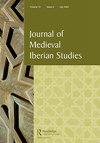圣歌编辑和分析程序:一个分析礼拜圣歌的工具
IF 0.4
2区 历史学
0 MEDIEVAL & RENAISSANCE STUDIES
引用次数: 0
摘要
直到最近,古西班牙圣歌很少受到仔细的音乐分析,部分原因是它以非音高记谱法保存下来。虽然我们可以读懂旋律的轮廓——上下乐章,但它们不能可靠地转录成现代乐谱。本文介绍了圣歌编辑和分析程序,并说明了它如何促进对剧目的分析。本文章由计算机程序翻译,如有差异,请以英文原文为准。
Chant editing and analysis program: a tool for analyzing liturgical chant
ABSTRACT Until recently, Old Hispanic chant was rarely subjected to close musical analysis, in part because it is preserved in unpitched notation. Although we can read the contours of the melodies—the up and down movements—they cannot be reliably transcribed into modern notation. This paper introduces the Chant Editing and Analysis Program and shows how it facilitates analysis of the repertory.
求助全文
通过发布文献求助,成功后即可免费获取论文全文。
去求助
来源期刊

Journal of Medieval Iberian Studies
MEDIEVAL & RENAISSANCE STUDIES-
CiteScore
1.20
自引率
20.00%
发文量
24
 求助内容:
求助内容: 应助结果提醒方式:
应助结果提醒方式:


